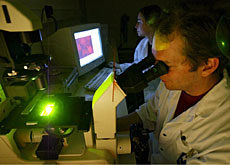Scientists split over biotechnology

Scientists in Switzerland disagree over the benefits and risks of genetically modified organisms (GMOs) for agriculture.
On November 27, it will be up to voters to decide in a referendum whether to introduce a five-year moratorium on the use of GMOs.
The proposal raises many questions of an ethical, social and economic nature. But the crux of the matter is still scientific.
The problem arises when the scientists are unable to agree among themselves. And studies on the topic often arrive at different conclusions.
This was the case with two recent studies on the possibility of a co-existence in Switzerland between transgenic and traditional crops. One study, commissioned by environmental group WWF, states that co-existence is virtually impossible. The other, conducted on behalf of the federal government, claims the opposite.
Ancient technology
Some of those researchers opposed to the moratorium are almost surprised at the fears that have arisen over biotechnology.
“Basically, this is just a new stage in a long process of species selection used in agriculture,” said Pierre Spierer, dean of Geneva University Faculty of Science.
“Transgenesis uses natural genes that are already ending up on our plates, just recombined in a different way.”
Of course, he admits, scientists don’t know everything. Doubts about the effects of biotechnology remain. “But I think we will have to copy an attitude that is widespread in the US. There, when problems are identified they are studied. In Europe, we tend to err too much on the side of caution,” Spierer told swissinfo.
Of course, caution is required when major problems arise. “But I don’t know of any epidemic that was caused by GMOs. And in some countries, transgenic foods have been consumed for over ten years,” he said.
Organic GMOs?
“Biotechnology could offer many benefits for Swiss agriculture,” confirmed Wilhelm Gruissem, professor at the Institute of Plant Sciences at the Federal Institute of Technology in Zurich.
“For example, it could help to reduce the quantity of pesticides used or provide a solution to the problem of excessive use of fertilisers.”
“It is mistaken to believe that organic agriculture and GMOs are mutually exclusive,” he observed. In Gruissem’s opinion, biotechnology, if used in agriculture that respects the environment and that aims to limit the use of chemical products, could even help to develop the organic sector.
“I’m convinced that consumers would understand. However, we have to be able to explain the benefits of GMOs. That’s why I’m in favour of a dialogue between scientists and the public rather than imposing bans.”
Long-term consequences
“The risks of biotechnology are neither easy to predict nor to deal with,” admitted Daniel Ammann, of the Swiss working group on gene technology. “There are, however, several problems that are very familiar and that cannot be ignored.”
For example, Ammann mentions the consequences of excessive use of pesticides in cultivating transgenic plants that are resistant to herbicides. “In the meantime, many weeds have developed resistance to herbicides.”
These are, of course, only indirect consequences of transgenic crops. Still more concrete hypotheses on the direct effects of GMOs exist.
“Studies demonstrate the harmful effect of BT corn [which contains a gene of the bacillus thuringensis] on insects that are useful to agriculture,” Ammann told swissinfo.
Amman points out that very few studies have been conducted on the health-related consequences of GMOs. “And yet some of these studies, conducted on rodents, point to serious problems that should be analysed in greater depth.”
“The fact is that the effects of GMOs will only be seen in the long term. This is why, given the current level of knowledge, we are very critical of the use of GMOs in food,” Ammann concluded.
swissinfo, Andrea Tognina
A study commissioned by the WWF concluded that coexistence is possible only if safety distances are respected between traditional and transgenic crops, ranging from 4km for rape to 1,000 metres for maize and sunflowers.
In a country like Switzerland with limited areas of farmland, this is tantamount to saying that coexistence is impossible for many crops.
Another study, conducted on behalf of the government, says analyses conducted abroad show that a distance of 25-50 metres is sufficient for avoiding, or at least containing, cross-fertilisation between transgenic and traditional crops.

In compliance with the JTI standards
More: SWI swissinfo.ch certified by the Journalism Trust Initiative











You can find an overview of ongoing debates with our journalists here . Please join us!
If you want to start a conversation about a topic raised in this article or want to report factual errors, email us at english@swissinfo.ch.